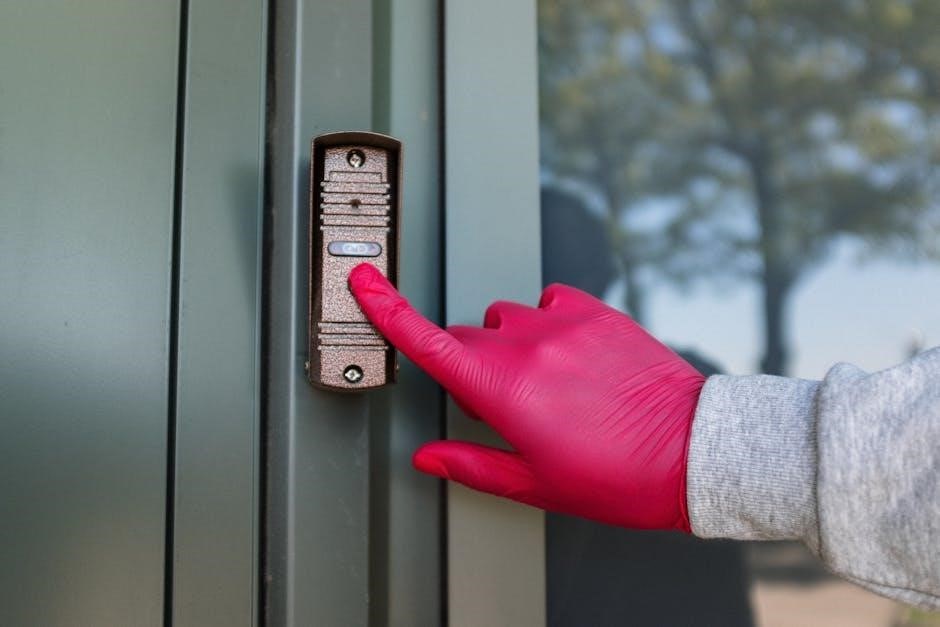
Congratulations on choosing Honeywell Security Systems, a leader in advanced home protection. This guide helps you navigate features, from basic operations to smart integrations, ensuring maximum security and convenience.
1.1 Overview of Honeywell Security Systems
Honeywell Security Systems are renowned for their advanced technology and reliability, offering comprehensive protection for homes and businesses. These systems integrate intrusion detection, video surveillance, and smart home automation, providing a seamless security experience. With user-friendly interfaces like the Alpha Display Keypad and touchscreen options, users can easily navigate and control their security setup. Honeywell systems are scalable, catering to various property sizes and security needs. They also support remote access through platforms like Total Connect 2.0, enabling users to monitor and manage their systems from anywhere. Known for their durability and innovative features, Honeywell Security Systems are a trusted choice for modern security solutions. Their commitment to updates, such as HomeKit compatibility, ensures they remain at the forefront of security technology.
1.2 Benefits of Using Honeywell Security Systems
Honeywell Security Systems offer unparalleled protection and convenience, making them a top choice for modern security needs. With advanced features like remote access, smart home integration, and real-time notifications, users gain complete control over their security setup. The systems are designed to be user-friendly, ensuring easy navigation for all skill levels. Additionally, Honeywell’s commitment to innovation provides compatibility with platforms like HomeKit, enhancing functionality. These systems also support DIY installation, reducing costs and offering flexibility. Their reliability and durability ensure long-term protection, while regular updates keep them at the forefront of security technology. Honeywell Security Systems are a smart investment for anyone seeking robust, adaptable, and efficient security solutions.
1.3 Quick Start Guide for Honeywell Security Systems
Welcome to your Honeywell Security System! To get started, power on the system and follow the on-screen instructions. Program user codes and authorization levels to ensure secure access. Test the system by arming and disarming it to confirm proper functionality. Familiarize yourself with the keypad or touchscreen interface, exploring basic operations like zone management and event logging. Refer to the Control Panel User Guide for advanced features and troubleshooting tips. Regularly update your system to maintain optimal performance and security. This guide provides a foundation, but explore additional resources for mastering all features. Enjoy enhanced safety and convenience with your Honeywell Security System!
Installation and Setup
Installing Honeywell Security Systems involves pre-installation checks, step-by-step setup, and configuring basic settings. Ensure all components are compatible and follow the user guide for a smooth process.
2.1 Pre-Installation Requirements

Before installing your Honeywell Security System, ensure all components are compatible and approved by Honeywell. Verify the system’s power requirements and ensure a stable electrical supply. Check for any existing smart home devices to confirm integration compatibility. Review the user manual for specific installation guidelines and safety precautions. Ensure the control panel is placed in an accessible location, and all sensors are positioned correctly. Test any wireless devices to ensure proper signal strength. Familiarize yourself with local regulations regarding security systems. Gather all necessary tools and materials before starting the installation process to avoid delays. Proper preparation ensures a smooth and successful setup.
2.2 Step-by-Step Installation Process
Begin by mounting the control panel in a central, accessible location. Connect the power supply and battery backup according to the manual. Install door and window sensors, ensuring proper alignment and secure fastening. Wire motion detectors and keypads, following the system’s wiring diagram. Test all sensors to ensure proper communication with the control panel. Program the system using the keypad or touchscreen, following the on-screen prompts. Activate and test the system to confirm all components function correctly. Refer to the user manual for specific wiring and configuration details. Complete the installation by performing a final system test to ensure reliability and security.
2.3 Configuring Basic Settings
After installation, access the system settings via the keypad or touchscreen. Program user codes, ensuring each code is unique and assigned to authorized individuals. Set entry and exit delays, typically 30-60 seconds, to allow time for arming and disarming. Configure arming modes, such as “Away” or “Stay,” to match your security needs. Define zones for doors, windows, and motion detectors, ensuring proper labeling for easy identification. Review and adjust default settings, like chime modes or alarm durations, to suit your preferences. Save all changes to ensure they take effect. Finally, test the system to confirm all configurations work as intended, providing a secure and user-friendly experience.
Keypad Functions
Honeywell keypads, including Alpha Display and Touchscreen models, enable arming/disarming, zone management, and access to advanced features, providing intuitive control over your security system’s operations and settings.

3.1 Understanding the Alpha Display Keypad
The Alpha Display Keypad is a user-friendly interface for Honeywell security systems, offering clear text-based commands and status updates. It features a backlit LCD screen, making it easy to navigate even in low-light conditions. Users can perform basic operations like arming and disarming the system, bypassing zones, and viewing event logs. The keypad also supports advanced functions, such as customizing user codes and adjusting system settings. Its intuitive design ensures that both new and experienced users can operate the system efficiently. Regular updates and compatibility with various Honeywell models make it a reliable choice for home security management.

3.2 Navigating the Touchscreen Keypad
The Honeywell Touchscreen Keypad, such as the 6290W model, offers an intuitive interface for managing your security system. Its vibrant display provides clear menus and icons, allowing users to easily navigate through settings. Key features include arming/disarming the system, viewing event logs, and adjusting configurations. The touchscreen is responsive, ensuring quick access to critical functions. Advanced features like console emulation mode enable deeper customization. The keypad also supports backlit displays for visibility in low-light conditions. With its user-friendly design, the touchscreen keypad simplifies security management, making it accessible for both novice and experienced users. Regular updates ensure compatibility with the latest Honeywell security systems.
3.3 Basic Keypad Operations
Mastering basic keypad operations is essential for effective use of your Honeywell security system. Start by entering your user code to access the menu. Use the numeric keypad to input codes, arm, or disarm the system. The Alpha Display Keypad provides clear text prompts, while the Touchscreen Keypad offers intuitive icons. Key functions include bypassing zones, viewing system status, and silencing alarms. Press the Escape button to return to the home screen. Regularly test your keypad to ensure all buttons are functioning properly. Familiarize yourself with basic commands to enhance your security experience. Always refer to your user guide for specific keypad models and advanced features.

Arming and Disarming the System
Understanding arming and disarming is crucial for system operation. Enter your code to arm in Stay or Away mode, or disarm using your key fob. The system provides real-time status updates and allows scheduling for added convenience.
4.1 Arming the System in Away Mode
Arming your Honeywell security system in Away Mode provides full protection by activating all sensors. To arm the system, enter your user code on the keypad, then select the Away option. The system will confirm arming with a beep and display a message. Ensure all doors and windows are closed before arming, as open zones will trigger alarms. Away Mode is ideal when no one is home, offering maximum security. The system also features an exit delay, allowing you to leave the premises after arming. For convenience, you can arm the system remotely using the Total Connect app. Always test the system after arming to ensure proper functionality.
4.2 Disarming the System
To disarm your Honeywell security system, enter your valid user code on the keypad. The system will confirm disarming with a beep and a “Ready to Arm” message. If disarming remotely, use the Total Connect app to deactivate the system. Ensure you have authorization to disarm, as the system tracks user activity. After disarming, all zones are deactivated, and the system returns to ready mode. If a false alarm occurs, disarm immediately to avoid unnecessary notifications. Always verify the system status on the keypad or app after disarming. For added security, test the system periodically to ensure proper functionality. Disarming is straightforward, but always follow the sequence carefully to maintain system integrity.
4.3 Scheduling Arming and Disarming
Honeywell security systems allow you to schedule arming and disarming for convenience and enhanced security. Use the Total Connect 2.0 app or the system’s keypad to set time-based rules. Program the system to arm automatically when you leave home or disarm when you return. Create custom schedules for weekdays, weekends, or specific events. This feature reduces the need for manual intervention and ensures your system is always active when needed. You can also set up notifications for when the system arms or disarms, providing peace of mind. Scheduling is particularly useful for businesses with fixed operating hours or homes with consistent routines. Test your schedule to ensure it works as intended and adjust as needed for optimal performance.

Zones and Partitions
Honeywell security systems use zones and partitions to organize protection. Zones monitor specific areas, while partitions divide the system for tailored security. This setup enhances overall control and management.
5.1 Configuring Security Zones
Configuring security zones in Honeywell systems allows precise control over monitored areas. Each zone can be assigned to specific sensors, such as door contacts or motion detectors. Users can customize zone names and settings through the keypad or touchscreen interface. This ensures that alerts are tailored to individual areas, reducing false alarms. Zones can also be bypassed temporarily for maintenance or convenience. Proper configuration ensures optimal system performance and personalized security. Refer to the user guide for step-by-step instructions to set up and manage zones effectively, ensuring your space is protected according to your needs.
5.2 Understanding Partitions
Partitions in Honeywell security systems allow you to divide your property into separate, independently controlled areas. Each partition can be armed or disarmed separately, providing flexibility for multi-zone properties. This feature is ideal for large homes or commercial spaces where different sections require unique security settings. Users can assign specific access levels to each partition, ensuring only authorized individuals can control them. Partitions enhance system customization, enabling tailored security solutions. For example, one partition can be armed while another remains disarmed. This functionality streamlines security management and offers greater control over your space. Refer to your user guide for detailed instructions on setting up and managing partitions effectively.
5.3 Bypassing Zones
Bypassing zones in Honeywell security systems allows you to temporarily deactivate specific zones without disarming the entire system. This feature is useful when you need to grant access to certain areas while maintaining security in others. To bypass a zone, access the system’s interface, select the zone you wish to bypass, and confirm the action. Bypassing zones is particularly handy for service personnel or guests who require limited access. Ensure that only authorized users can bypass zones by setting appropriate access levels. Remember to re-enable bypassed zones once the need has passed to restore full system protection. Always test the system after bypassing zones to ensure proper functionality.

Advanced Features
Honeywell Security Systems offer advanced features like remote access, smart home automation, and event logging. These features enhance security and convenience, providing a modern, integrated solution for home protection.
6.1 Remote Access and Control
Remote access and control with Honeywell Security Systems allow users to manage their security setup from anywhere using a smartphone or tablet. Through the Total Connect app, users can arm or disarm their system, receive real-time alerts, and monitor live video feeds. This feature enhances convenience and peace of mind, enabling users to respond quickly to security events even when they’re not physically present. Remote access also supports scheduling and custom notifications, ensuring a tailored security experience. With Honeywell’s advanced technology, staying connected to your home’s security has never been easier or more efficient.
6.2 Home Automation Integration
Honeywell Security Systems seamlessly integrate with smart home devices, offering a unified control experience. Users can connect their security setup with thermostats, lights, and door locks, creating a fully automated home environment. This integration allows for synchronized actions, such as turning on lights when the system is disarmed or adjusting the thermostat when leaving home. Compatibility with platforms like Apple HomeKit and Amazon Alexa enables voice control, enhancing convenience. The system also supports custom scenes and routines, ensuring a tailored automation experience. By merging security and home automation, Honeywell provides a comprehensive solution that simplifies daily life while enhancing safety and efficiency.
6.3 Event Logging and History
Honeywell Security Systems provide comprehensive event logging, allowing users to track all system activities. The event history includes details like arming/disarming, zone breaches, and user code entries. This feature enhances security monitoring by offering a clear audit trail. Users can access logs directly through the keypad or via the Total Connect 2.0 remote platform. Historical data helps identify patterns and ensures accountability. Customizable notifications alert users to specific events, providing real-time updates. The system also supports detailed reporting, which can be useful for maintenance, troubleshooting, or compliance purposes. By maintaining a record of all interactions, Honeywell ensures transparency and accountability, making it easier to manage and secure your property effectively.
User Management
Honeywell Security Systems allow centralized user setup, enabling authorization levels, partition assignments, and RF zone configurations. Extended functions are accessible via keypads or console emulation for advanced control.
7.1 Creating and Managing User Codes
Creating and managing user codes in Honeywell Security Systems is straightforward. Users can be programmed in a central setup location, assigning specific authorization levels, partition assignments, and RF zones. Each code can be tailored to individual access needs, ensuring security and convenience. Extended functions, such as advanced keypad operations, can be accessed through standard alpha keypads or the console emulation mode on touchscreens like the 6290W. Refer to the Control Panel User Guide for detailed instructions on these features. Proper management of user codes enhances system security and ensures only authorized individuals have access to specific functions and areas.
7.2 Assigning Access Levels
Assigning access levels in Honeywell Security Systems ensures users have appropriate permissions. Access levels can be set during user code creation, determining their ability to arm/disarm, access partitions, or view event logs. Basic levels include “User” for limited access and “Manager” for full control. Custom levels can be created to suit specific needs. Access levels are programmed in the central user setup, where authorization, partition assignments, and RF zones are defined. Regularly reviewing and updating access levels is crucial for maintaining system security. This feature ensures that only authorized individuals can perform specific functions, enhancing overall system protection and user accountability;
7.3 Monitoring User Activity
Monitoring user activity in Honeywell Security Systems is essential for maintaining security and accountability. The system allows you to track user actions, such as arming/disarming, zone bypasses, and access attempts. Event logs provide detailed records of all system interactions, including timestamps and user IDs. These logs can be viewed directly on the keypad or through remote access platforms like Total Connect 2.0. Regularly reviewing user activity helps identify unauthorized access or suspicious behavior. Additionally, you can generate reports for audits or further analysis. Real-time notifications can also be set up to alert you of specific events, ensuring prompt responses to security breaches. This feature enhances overall system transparency and control.
Integration with Smart Home Systems
Honeywell Security Systems seamlessly integrate with smart home devices, enhancing convenience and security. Compatible with platforms like Apple HomeKit, they offer voice control and remote access capabilities.
8.1 Compatibility with Smart Home Devices
Honeywell Security Systems are designed to integrate seamlessly with a wide range of smart home devices. Compatibility extends to platforms like Apple HomeKit, allowing users to control their security systems through Siri and other smart home hubs. Additionally, Honeywell systems work with popular smart thermostats, such as the Lyric Thermostat, ensuring a unified smart home experience. This integration enables features like voice commands, remote access, and automated settings, enhancing both convenience and security. By connecting your Honeywell system to smart devices, you can create a cohesive and intelligent home environment tailored to your needs.
8.2 Setting Up Smart Home Integration
Setting up smart home integration with Honeywell Security Systems is straightforward. Ensure your system is compatible with platforms like Apple HomeKit or Total Connect 2.0. Start by updating your system’s firmware to the latest version. Use the Honeywell Home app to link your security system with smart devices, such as thermostats or lights. For HomeKit integration, scan the QR code on your control panel or enter the code manually. Configure settings to enable voice control via Siri or automate routines based on system events. Refer to the Total Connect 2.0 Interactive User Guide for detailed steps. Proper setup ensures seamless integration, enhancing your home’s security and convenience.
8.3 Benefits of Smart Home Security Integration
Integrating Honeywell Security Systems with smart home devices offers enhanced security, convenience, and energy efficiency. With platforms like Apple HomeKit or Total Connect 2;0, users can control their security system and smart devices seamlessly. Voice control via Siri enables hands-free arming, disarming, and automation of routines. Remote access allows monitoring and adjustments from anywhere, ensuring peace of mind. Smart home integration also optimizes energy use by syncing thermostats with security statuses. Automated lighting can deter intruders by simulating occupancy. These features not only strengthen security but also simplify home management, making Honeywell systems a comprehensive solution for modern living.

Troubleshooting and Maintenance
Identify common issues like low battery warnings or sensor malfunctions. Regularly test systems, check power supplies, and ensure all devices are Honeywell-approved for optimal performance and reliability.
9.1 Common Issues and Solutions
Common issues with Honeywell security systems include low battery warnings, sensor malfunctions, and error codes. For low battery alerts, replace the battery promptly to maintain system functionality. Sensor issues often arise from dirt or misalignment; clean and adjust sensors as needed. Error codes like “FC” or “Fire” indicate specific problems, which can be resolved by referencing the user manual or contacting support. Regular system testing and updates help prevent these issues. Always ensure devices are Honeywell-approved to avoid compatibility problems. Addressing these common issues promptly ensures your system remains reliable and provides consistent protection for your home or business.
9.2 Performing Regular System Maintenance
Regular maintenance is crucial to ensure your Honeywell security system operates efficiently. Test all sensors monthly to confirm they trigger alerts correctly. Check for firmware updates and install them promptly to enhance functionality and security. Inspect wiring and connections for damage or wear, and clean sensors and keypads to prevent false alarms. Refer to the user manual for specific maintenance instructions tailored to your system. Additionally, schedule annual professional inspections to address complex issues. By maintaining your system regularly, you ensure reliable protection and extend its lifespan. A well-maintained system provides peace of mind and optimal performance for your home or business security needs.
9.3 Understanding Error Codes
Honeywell security systems display error codes to indicate specific issues, helping you identify and resolve problems quickly. These codes, such as “Check 1” or “Sensor 2 Fault,” appear on your keypad or touchscreen. Refer to your user manual for a detailed list of codes and their meanings. Common errors include sensor malfunctions, communication failures, or low battery warnings. Addressing these issues promptly ensures your system remains functional and secure. If an error persists after troubleshooting, consult the manual or contact Honeywell support for assistance. Regularly reviewing error codes helps maintain system reliability and prevents potential security breaches. Always keep your manual handy for quick reference when resolving these issues.
Honeywell Security Systems offer comprehensive protection with advanced features. For further support, visit Honeywell’s official website or download the Total Connect 2.0 app for remote access and updates.
10.1 Summary of Key Features
Honeywell Security Systems offer a robust suite of features designed to enhance home and business security. Key functionalities include remote access and control through the Total Connect 2.0 app, enabling users to arm/disarm systems, receive alerts, and monitor events remotely. The systems support smart home integration, allowing seamless control of security, thermostats, and lighting from a single interface. Advanced user management allows creation of multiple access levels, ensuring only authorized individuals can operate the system. Event logging provides a detailed history of system activities, while compatibility with devices like the Lyric Thermostat and HomeKit further expands functionality. These features ensure a secure, convenient, and integrated security solution.

10.2 Where to Find Additional Support

For additional support with your Honeywell Security System, visit the official Honeywell website, which offers comprehensive resources, including user manuals and installation guides. The Total Connect 2.0 Interactive User Guide is available on iTunes, providing detailed instructions for remote access features. YouTube tutorials and Honeywell’s customer support team are also excellent sources for troubleshooting and advanced configurations. The VISTA-15P/20P/SIA User Guide is a valuable resource for understanding system operations. Additionally, Honeywell’s Home website provides FAQs, video guides, and software updates to ensure optimal system performance. For personalized assistance, contact Honeywell’s customer service or authorized dealers for professional guidance.
10.3 Staying Updated with Honeywell Security
To stay updated with Honeywell Security, regularly visit the official Honeywell website for the latest software updates, feature enhancements, and user guides. Subscribe to Honeywell’s newsletter for notifications on new products and security advancements. Additionally, Honeywell frequently releases updates for systems like the Lyric Thermostat and HomeKit integration, ensuring compatibility with the latest smart home technologies. For the most current information, check Honeywell’s social media channels and support forums. The Total Connect 2.0 Interactive User Guide, available on iTunes, is regularly updated to reflect new features. By staying informed, you can maximize your system’s performance and security capabilities.